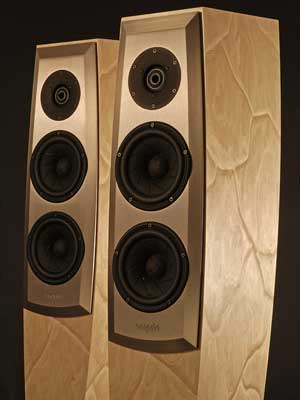 |
|||||||
| |
|
|
|
 |
|
|
|
Appearance: I always like slim enclosures, because they are relatively easy to place. The Perfection One is such a design, sporting a small footprint of 6 1/4 X 14 inches (W X D) with a medium height of only 38 inches. On the baffle, a 21-inch aluminium plate is placed, likely to assist driver mount integrity. Designed for time alignment, the enclosures top part leans about 15 degrees back from the base. A spiked aluminium plinth with built-in milled WBT NextGen binding posts, provides stability and anchors the cabinets firmly to the floor. (On a hardwood floor, it’s wise to use little pads to avoid scratches). Two flared aluminium ports (one on top, one on the bottom) open on the enclosures' immaculately finished rear. Though there are “nice little grilles” (mountable with magnets) for decoration, I’d suggest taking them off before serious listening. The Perfection One looks very elegant and is available in four premium finishes — satin white, maple, Namibia rift, rose burl and black piano. The Sound For the auditions, I used my in-house Wyetech Labs, Opal preamplifier, one Bryston 14BSST amplifier, one 8 watts/ch Art Audio Symphony single-ended amplifier and a pair of prototype monoblock power amps by Wyetech Labs, the soon to be available 32 watts/ch (single-ended) Ruby. Audio Aero’s new Capitole Classic CD player and a mass of interconnects and speaker cables from JPS Labs — the Aluminata series, Nordost — the Valhalla Series and BIS Audio Maestro Series made up the balance of the system components, all plugged into my old Tice power line conditioner. The various system combinations allowed me to arrive at a fair assessment of the Perfection One loudspeakers and their most conspicuous attribute— imaging. These enclosures can’t be considered small, yet they render a sound stage one would expect from small, point-source-like designs. The overall sound stage is big with great horizontal spread, an impressive vertical reach, and an awesome front-to-back range. I had placed the speakers in front of and on each side of my listening room’s fireplace, and while using this placement with other loudspeakers, never reached the height of a sound stage as impressive as with the Perfection Ones. Using some of my favourite auditioning music , the speakers seemed not to be where I placed them. The sound was indeed, way out of the box. Perception aside, I went to work and began testing the speakers' ability to reach into the bass region. For this listening test, I used my old Todo Sobre Mi Madre CD (Universal 676 208-2) and an older Dorian CD titled The Great Organ Of Saint Eustache (Dorian 90134) with a wonderful rendition of Bach’s “Toccata and Fugue in D Minor.” The Universal CD quickly showed the Neeper's ability to reach down to its specified 30Hz. The Dorian recording features organ pedal-notes reaching down to 24.5Hz, just a little lower than the Perfection One’s reach to the bottom fundamentals with resolution. However, I didn’t sense any omitted frequencies, as the loudspeakers’ power and clarity was accomplished and authentic, regarding size and tonal integrity. To test the midrange, I used Carmen McRae’s Fine And Mellow and Gene Harris’ Listen Here (both Concord recordings SACD1005-6 & SACD 1006-6). McRae’s voice is a mellow mezzo, which she uses like an instrument, actually like many instruments with various tonal attributes. This well-produced live recording (available in SACD) is perfectly suited to check a loudspeaker’s ability to recreate the recording space, the voice’s character, and the degree of refinement. Well, all was right in the midrange as every note, regardless of intensity, was controlled, with smooth transitions to upper and lower frequencies. The lack of edginess underscored McRae’s breathy voice throughout the auditions, making it relaxed listening at its best. Her back-up group (organ, sax, guitar, and drums) was clearly audible at stage left, right, and centre, with every tone in its own space and in absolute focus, including the most difficult-to-achieve front-to-back scope.
I'm thrilled to see that the industry attracts new, young talent to perpetuate the science and art of high-end audio. If I didn’t know this designer’s age I would ascribe the design expertise to a veteran in the field. Consequently, I am intrigued by this young man’s focus on quality components, his attention to artisanship, and his understanding of the importance of loudspeakers to reproduce, rather than produce. I believe Rasmussen succeeded by designing a very revealing loudspeaker that reflects the quality of its back-up components. My personal preference in loudspeaker design is what I call an “organic” sound — an attempt to explain a natural type of sound with the loudspeaker out of the way of the music. The Perfection One has a good portion of this organic sound quality, but a good part of its performance characteristic is its unique sonic signature, its voice. And what a voice! A multi-octave range, a tenor, a baritone, a bass, a soprano and much more in one small, beautiful package I’d call damn close to perfection. Rasmussen states that he knew what he wanted in terms of loudspeakers: Not speed, size, or pretentiousness “an intangible combination of design, materials and, of course, performance that makes it desirable above all others." Well, he may have done it, for the bottom line is that the Perfection One ranks amongst the few designs I’d rate as state-of-the-art. Did I mention price? It is mentioned in the right place (under Facts) but I think that this speaker’s performance alone should be equated with high-end. Can we look for a Perfection Two? I hope so. Rasmussen did say that, in good time, more Neeper Acoustics products will follow and will include larger, smaller and centre-channel speakers as well as subwoofers.
|
|
| News | Reviews | Commentary | Marketplace | Contact Us | Home |

